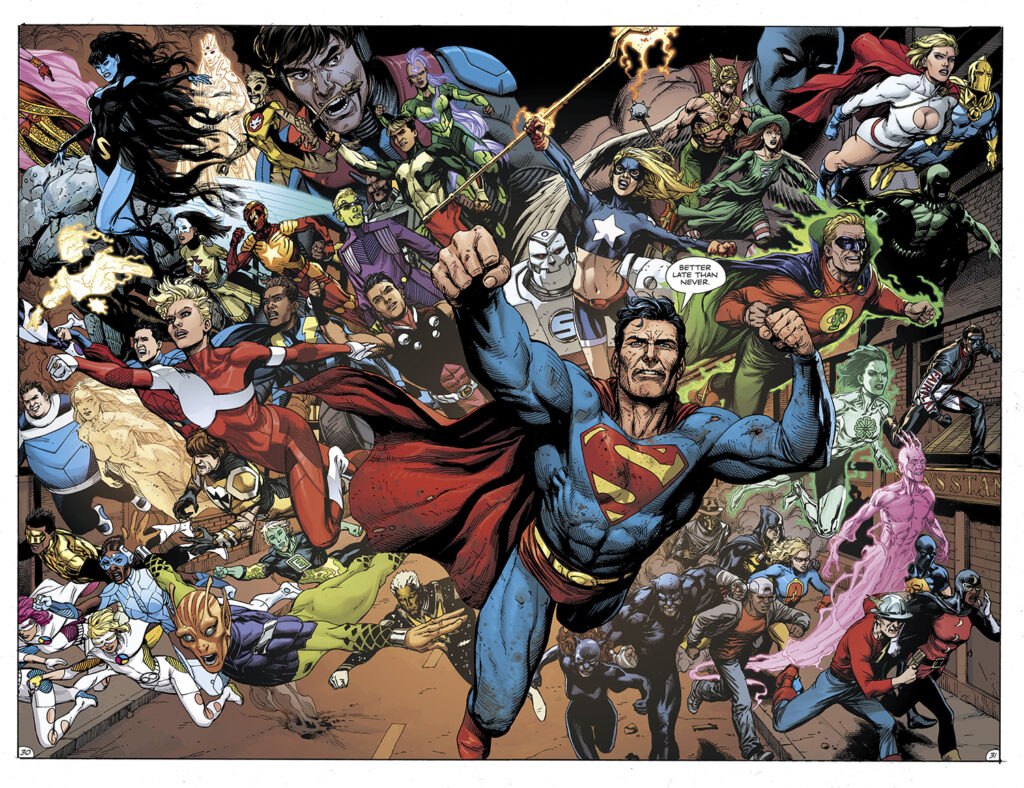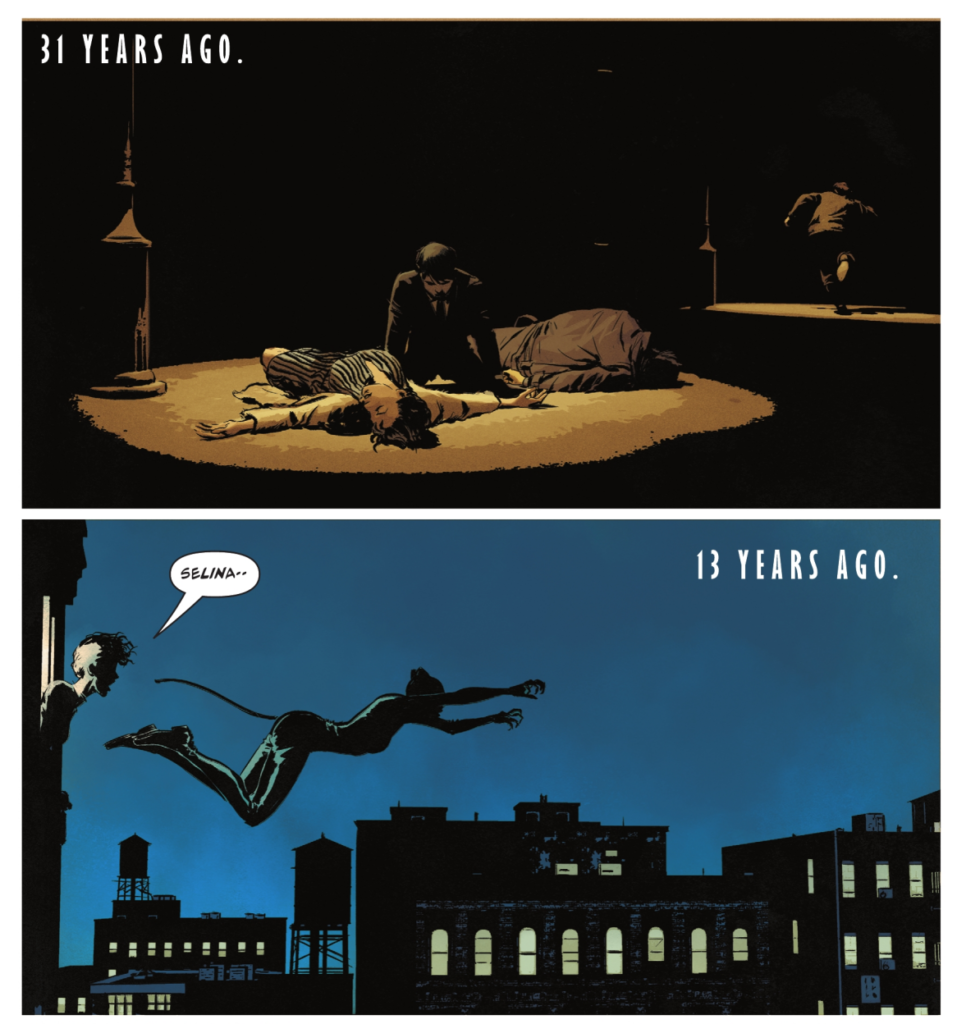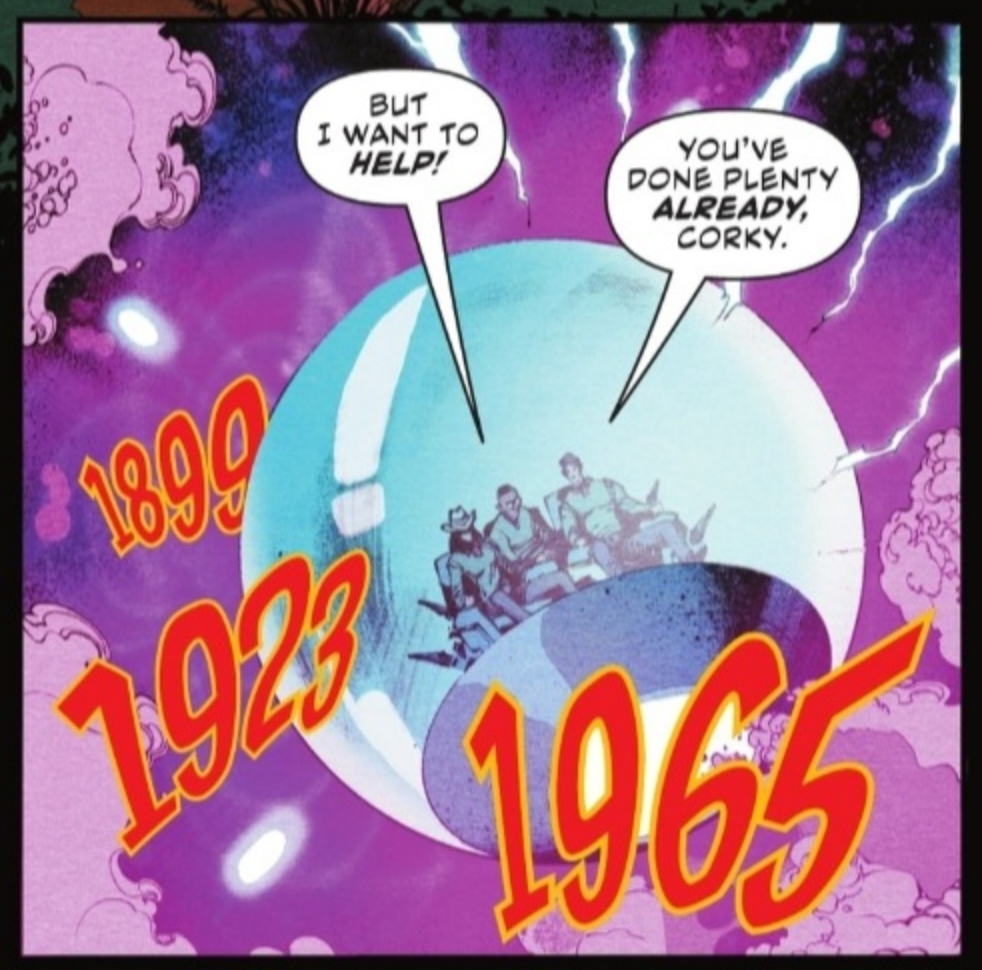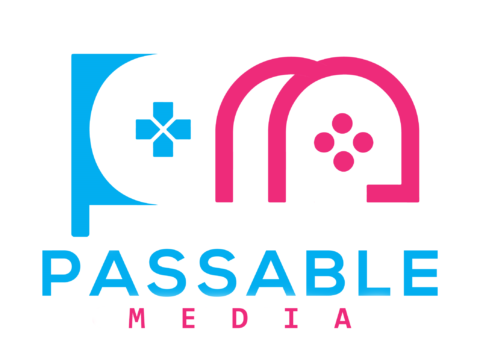For the past several years, we had a DCU timeline that really seemed to work. It made sense. And it made sense in a lot of ways that previous timelines didn’t. Go on Reddit or the Comic Book Resources message boards and you’d see a general consensus that the JSA debuted in the late 1930s or early 1940s, Batman and Superman debuted about twenty to twenty-one years ago, and the JLA formed at some point shortly thereafter. This agreement spoke to a publishing line that was taking great care to make sure things tracked. This was continuity functioning as it should.
Then along came Geoff Johns to throw a big fat monkey wrench into the stinkin’ works.
According to The New Golden Age and JSA #1, Batman debuts a mere thirteen years ago, while Helena is born around 2023. When Helena is in elementary school (around age nine), she discovers her dad is Batman, at which time Selina forces Bruce to retire. In roughly 2040, Batman is seemingly killed. This will all be followed up in the twelve-issue JSA series, so a lot of answers could be given, and we shouldn’t take anything at face value until it ends. But with such specificity of dates and times, Johns seems to be doing… something specific.
Let’s start with Johns’ supposed future. Does it leave any place at all for Terry McGinnis? If so, all of Batman Beyond would have to go between 2032 and 2040, if indeed Batman is actually killed and stays dead in 2040. There are a lot of ways to view the future when it comes to comic books. For instance, is this future even set in canon? For that matter, are any futures? We’ll get into that in a soon-to-come follow-up blog post, but for now, I’ll leave the conversation with the fact that Johns posits a world where Helena is born “one year from now.” Are other comic book writers going to be committing to this scenario in a mere year’s time?
But let’s move on from the future and focus on what’s more important—the idea of Batman debuting thirteen years ago. It means that Bruce is born in 1982, which is not far off from what we already currently have, so that’s fine. If the Waynes are killed when Bruce is eight-years-old, that places the tragedy in 1991, which is indeed “31 years ago” as JSA #1 tells us. Johns’ implication is that Bruce trains from age eighteen until twenty-five (mirroring Frank Miller’s “Year One”). And then “13 years ago” is 2009, meaning Batman debuts at age twenty-five/twenty-six (again mirroring Frank Miller’s “Year One”).
Here’s where things get complicated and messy. For Johns’ “13 years ago” timeline to work, this means that Year One must include a lot of stuff, some of which is quite anachronistic. He must come face-to-face with the League of Assassins, during which Damian must be conceived. Damian must also be born in Year One as well. Dick would likely have to become Robin in Year One too—putting us right back into a New 52 Robin-as-internship situation. And Jonathan Kent must be conceived and born as well. Would that mean that Doomsday’s murder or Superman comes early too (as in basically immediately after he debuts)? That’s particularly messy—and likely impossible—for various reasons. Not to mention, we’ve already gotten numerous references and flashbacks to Doomsday that involve a later JLA lineup and which are based upon 1993 story material.
No matter how you spin it, a thirteen-to-fourteen-yearlong timeline requires a lot of compression, which is difficult when Johns himself restored so much continuity with Doomsday Clock (and Scott Snyder and Joshua Williamson opened up everything with “everything matters”). Where would we even compress? The early years? The middle? Surely Johns, who adores the Silver Age, isn’t suggesting that decades’ worth of that precious material get crammed into a three or four year span? The New 52 ended over five years ago. If we keep five years of story, even compressing it down a wee bit, you still aren’t left with much breathing room for eight decades of stories. And if we compress more recent stories in order to make things work, is that technically a reboot? Is it a soft reboot? Is it an official time-slide? What is it?
Let’s not forget though, not only has New Golden Age/JSA just begun, but it’s also a story heavily revolving around time-travel. With all the chronal shenanigans pertaining to the New Golden Age/JSA narrative, it’s possible that we could be dealing with alternate timelines and alternate Earths—and subsequent time-chicanery that could undo itself by arc’s end. But that remains to be seen. This is precisely why I’ve decided not to place any New Golden Age or JSA stuff on my chronology until the arc fully wraps.
Until then, and I hate to do it, I’ll delve into some conspiracy theorization. After all, I have sneaking suspicions about what’s going on, and it might have to do with fallout from the end of the Dan DiDio regime. Johns’ original intention with Doomsday Clock had been to fully reboot the DCU, going straight into Flashpoint Beyond and New Golden Age/JSA. This is precisely why he had the JSA return (with reboot) at the end of Doomsday Clock in the first place. Of course, Johns’ reboot (and DiDio’s 5G reboot) were both blocked/rejected in favor of Snyder/Williamson’s “anti-reboot” with Death Metal and Infinite Frontier. Now that Johns is back in the leadership saddle, he appears to be continuing with his original plans, despite having had a couple years of Snyder-influenced Williamson “anti-reboot” continuity.

In any case, as I said above, I want to see the forest for the trees—step back once Johns is done with JSA to see if I can better understand his rationale. Either it’s an out-and-out reboot, a soft reboot with sliding-time (i.e. compression), or something else entirely. But again, Johns had a hard-on for a reboot a few years ago and didn’t get his way. I wouldn’t put it past him to be rebooting without fanfare, now that he’s got the power. Though, could we also see a reboot-ish type thing at the end of Dark Crisis on Infinite Earths? A new “dawn” is coming, after all. Keep an eye on that one too. Always more to come…





I know I’m focusing on the wrong things here so sorry in advance. Where did you hear JSA is a maxi and not an ongoing? It also seems like Death Metal/Dark Crisis is still the basis of DC rather than Johns and Johns is kind of off in his own pocket. It’s a weirder more interesting direction than Dark Crisis but I don’t think it’s the main one. But I’m happy to be wrong if I’m wrong 🙂
DC’s own solicitations list it as a 12-issue series, I believe. Right now, Johns definitely stands alone, but we shall see. Definitely more interesting than Dark Crisis, I agree!
My own baseless theory…since 5G gets dropped by name in Doomsday Clock, Johns maybe attempting his own version in miniature of it here so that they reference leads somewhere. Johns has become ostentatious enough in recent years to do such a thing.
Yes, Johns’ moves are definitely worth watching. I wouldn’t put it past him to really shake things up (or at least try to in his own titles). One wonders how much pull he has behind the scenes. He and Mark Waid certainly seem to be the line-runners at the moment.
Real talk, except for Earth-Two (Golden Age), I don’t think there’s any such thing as a definitive future for the mainstream Batman. So, I don’t put any stock in any of them. They’re ALL possible futures that end up getting cancelled out as the comics go on and make room for new possible futures. I don’t think any of them will actually happen.
Earth-Two’s is the only definitive one because it’s the only one that actually came to fruition and existed prior to “Crisis” wiping it out. Every other version of the mainstream Batman never achieved a definitive future. They just got erased/evolved by some reality-warping event and THAT was the end for them.
You may be right about this one, who knows, but that’s where things stand from my POV.
Hey Batfan! I wrote a recent blog post tackling exactly what you are talking about here. The topic is basically “How does the future work in continuity comics?” Check it out at https://therealbatmanchronologyproject.com/physics-of-the-future/
Maybe I’ll add your take into the mix, putting you as a devotee of the “all futures are false” camp 🙂
My main sticking point is always that certain future items have significant bearing or directly connect to the past or present, especially via means like time-travel. These things can’t simply be hand-waved away. If the future isn’t set in stone (which also doesn’t really make sense in terms of physics), then this means that the aforementioned solid connective tissue of the future must still exist but get relegated to some sort of alt-timeline/Hypertimeline thing. Even for timelines that end with a Crisis, they don’t end at the end of the timeline. Their Crises involve future characters. These timelines get erased but not in a linear fashion. Clearly, things are not so cut and dry.
Update: I added a paraphrased version of your comment to the article, so thanks for the input!